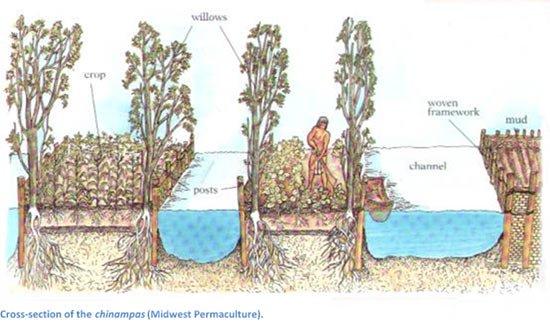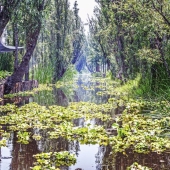
 1
1





These data clearly indicated that during radiation frost conditions, a microclimate develops that is considerably and consistently warmer then the air above a similarly positioned dry land field.
...
The author concludes that sub-irrigation has been overemphasized as a feature of both pre-Hispanic and modern wetland agriculture, while frost risk reduction has been an under appreciated result of the creation of chinampa agriscapes. Restoration of past water levels in the chinampa canal system may be desired primarily to achieve increased frost risk reduction, not sub-irrigation
They were created by staking out the shallow lake bed and then fencing in the rectangle with wattle. The fenced-off area was then layered with mud, lake sediment, and decaying vegetation, eventually bringing it above the level of the lake.
There is evidence that the Nahua settlement of Culhuacan, on the south side of the Ixtapalapa peninsula that divided Lake Texcoco from Lake Xochimilco, constructed the first chinampas in C.E. 1100
 1
1




A human being should be able to change a diaper, plan an invasion, butcher a hog, conn a ship, design a building, write a sonnet, balance accounts, build a wall, set a bone, comfort the dying, take orders, give orders, cooperate, act alone, solve equations, analyze a new problem, pitch manure, program a computer, cook a tasty meal, fight efficiently, die gallantly. Specialization is for insects.
-Robert A. Heinlein
 1
1





 1
1




List of Bryant RedHawk's Epic Soil Series Threads We love visitors, that's why we live in a secluded cabin deep in the woods. "Buzzard's Roost (Asnikiye Heca) Farm." Promoting permaculture to save our planet.
 1
1












A human being should be able to change a diaper, plan an invasion, butcher a hog, conn a ship, design a building, write a sonnet, balance accounts, build a wall, set a bone, comfort the dying, take orders, give orders, cooperate, act alone, solve equations, analyze a new problem, pitch manure, program a computer, cook a tasty meal, fight efficiently, die gallantly. Specialization is for insects.
-Robert A. Heinlein




Chris Kott wrote:I'm sorry, my eyes don't seem to be working right. Are you saying that those islands are artificial?




we don't have a problem with lack of water we have a problem with mismanagement
beavers the original permies farmers
If there is no one around to smell you ,do you really stink!

|
Hustle until your haters ask if you’re hiring --tiny ad
The new kickstarter is now live!
https://www.kickstarter.com/projects/paulwheaton/garden-cards
|







